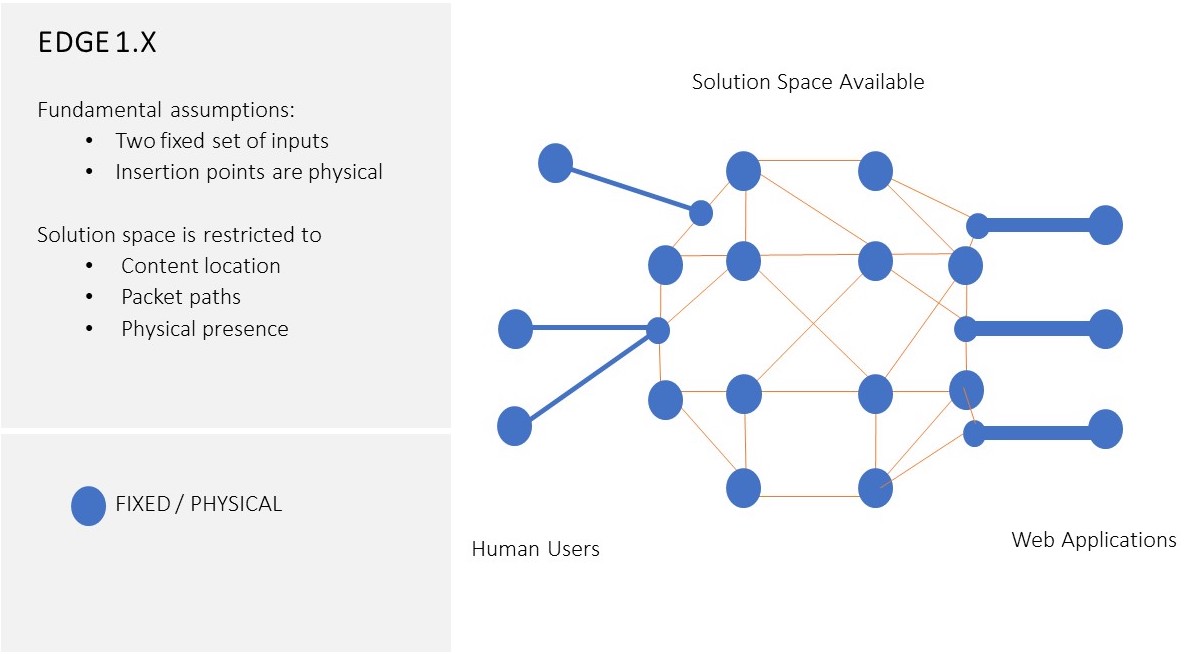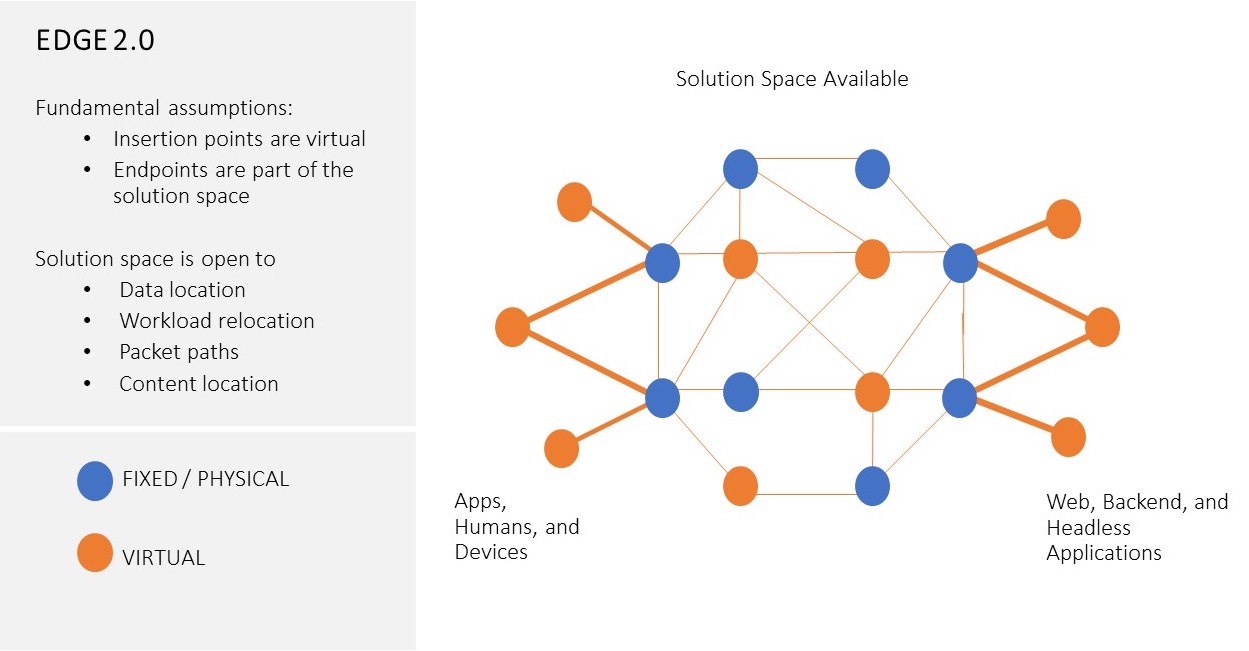Edge 2.0 선언문: 엣지 컴퓨팅 재정의
F5의 Volterra 인수 완료는 엣지 컴퓨팅의 다음 단계의 시작을 알리며, Edge 2.0 시대를 열었습니다. 우리는 Edge 2.0 시대에는 모든 산업 분야의 디지털 비즈니스가 애플리케이션을 제공하고 데이터를 처리 및 분석하기 위해 엣지 컴퓨팅 플랫폼을 도입할 것으로 예상합니다. 엣지 플랫폼은 모든 디지털 서비스의 사용자 경험에 필수적인 구성 요소가 될 것입니다.
이 글에서는 에지 아키텍처의 진화를 설명하고 Edge 2.0 패러다임에 대한 F5의 기술 비전을 논의하겠습니다.
엣지 1.0
엣지 기술은 수년 동안 초기 단계로 존재해 왔지만, 초점이 다릅니다. 인터넷이 등장한 초창기에는 정적 콘텐츠에 초점을 맞추었고 CDN(Content Delivery Network)이라고 불렸습니다. 월드 와이드 웹의 발명자인 팀 버너스 리는 느린 링크를 통해 방대한 양의 웹 콘텐츠가 전달될 때 인터넷 사용자가 겪게 될 혼잡 문제를 예견했습니다. 그는 이 문제를 "월드 와이드 대기"라고 불렀습니다. 이런 과제에 흥미를 느낀 MIT 교수 톰 리튼은 학술 연구를 통해 이 문제를 탐구했습니다. 1998년에 그와 그의 학생인 대니 루윈은 아카마이 테크놀로지스를 공동 창립했고, 이를 통해 콘텐츠 전송 네트워크 아키텍처 패러다임을 만들어냈습니다.
CDN 패러다임의 초점은 적절하게도 비교적 정적인 웹 콘텐츠나 웹 애플리케이션을 사용자에게 더 가깝게 전달하여 속도와 중복성에 대한 요구를 충족하는 데 맞춰졌습니다. 이러한 요구로 인해 최종 사용자와 가까운 물리적 접점(PoP), 콘텐츠 캐싱, 위치 예측, 혼잡 회피, 분산 라우팅 알고리즘 등을 포함한 핵심 아키텍처 원칙이 탄생했습니다. 네트워크와 장치는 바뀌었지만 이러한 설계 원칙은 오늘날에도 여전히 기본 CDN 아키텍처를 지배하고 있습니다.
엣지 1.5
그 사이에 인터넷 "콘텐츠" 생태계는 진화했습니다. 애플리케이션은 인터넷 상에서 주요 콘텐츠 형태가 되었습니다. 따라서 분산형 엣지는 초기의 형태로 지속될 수 없었습니다. 성장하는 디지털 경제를 보호해야 한다는 압력이 커지는 가운데 분산형 엣지가 제공하는 애플리케이션 아키텍처와 함께 진화해야 했습니다. 현재 글로벌 경제의 많은 부분이 상거래 중심 애플리케이션에 크게 의존하고 있기 때문에 보안 서비스는 CDN 공급업체의 추가 필수 요소가 되었습니다. 이러한 공급업체는 전 세계에 걸쳐 존재하며 사용자에게 더 가까이에 위치하고 있어 클라우드 및 기존 데이터 센터보다 더 일찍 위협을 해결했습니다. 이러한 서비스는 콘텐츠를 배포하기 위해 구축된 인프라를 기반으로 구축되었으므로 폐쇄적이고 독점적인 환경을 나타냅니다. 한 CDN 공급업체가 제공하는 서비스는 다른 공급업체와 호환되지 않으며 이전이 불가능합니다.
또한 원래 CDN 아키텍처 패러다임의 기본 설계 원칙은 Tim Berners-Lee의 원래 인터넷 "World Wide Wait" 과제를 해결하는 것을 목표로 했으며, 두 가지 엔드포인트(사용자와 사용자가 액세스하는 콘텐츠)가 비교적 수동적인 개체라고 가정하고 문제에 대한 솔루션을 주로 중간 계층, 이 경우 CDN에 위임했습니다. 인터넷 생태계의 발전, 특히 컨테이너 기반 마이크로서비스 애플리케이션과 지능형 최종 사용자 컴퓨팅으로의 전환은 그런 가정을 완전히 깨뜨렸습니다. Edge 1.x 아키텍처 구체의 개념적 보기는 그림 1을 참조하세요. 다음 섹션에서는 두 가지 요소에 대해 더 자세히 설명하겠습니다.

엣지 진화의 촉매
기업들은 여전히 정적 콘텐츠를 배포해야 하지만, 동시에 애플리케이션 아키텍처에서 Edge가 더 중요한 역할을 수행하기를 기대하고 있습니다. F5가 실시한 최신 조사에 따르면, 설문 조사에 참여한 기업의 76%가 성능 개선, 데이터 수집 및 분석 속도 향상, IoT 지원, 실시간 또는 거의 실시간 처리를 위한 기능 활용 등 다양한 사용 사례에 Edge를 사용할 계획이라고 밝혔습니다. 여기에는 간단한 CDN 기능 서비스를 위한 인프라에서의 역할이 전혀 없다고 예상하는 기업의 25%가 포함됩니다. 이러한 조직은 안전하고 최적의 사용자 경험을 제공하는 매우 역동적이고 전 세계적으로 분산된 애플리케이션을 만들고 있습니다. 그들은 Edge가 다중 위치 애플리케이션 서비스의 존재감과 유연성을 제공하고, 이를 성공적으로 수행하는 데 필요한 일관된 구성 요소를 제공하기를 기대합니다.
오늘날 Akamai, Fastly, Cloudflare와 같은 CDN 중심 아키텍처를 갖춘 Edge 제공업체가 제공하는 서비스는 이러한 애플리케이션 중심 기능을 제공하는 데 필요한 기본적인 특성이 부족합니다. 예를 들어, Kubernetes 기반 분산 애플리케이션의 경우 컨테이너 내부에 패킹된 애플리케이션 로직은 지원되는 Kubernetes 스택을 통해 적절한 컴퓨팅 위치로 동적으로 이동할 수 있습니다. 퍼블릭 클라우드의 IaaS 인스턴스, 기업이 소유한 물리적 서버 또는 Edge 공급자의 PoP에 있는 가상 머신 등 컴퓨팅 위치가 무엇이든 사용자 경험을 최적화하기 위해 이를 수행할 수 있습니다. 따라서 애플리케이션은 더 이상 전송 네트워크의 "수동적인" 라우팅 대상이 아니라 Edge 솔루션의 능동적 참여자가 됩니다. 이는 이러한 CDN 제공업체의 Edge 솔루션이 구축된 아키텍처 원칙과는 정반대입니다. 즉, 콘텐츠(또는 애플리케이션)가 물리적 위치와 관련된 정적 개체였던 시대에서 유래한 에지 솔루션은 콘텐츠 전송 네트워크만이 사용자를 애플리케이션에 연결하는 "지능형 플랫폼"으로 기능하고 애플리케이션(및 사용자)은 "지능형 플랫폼"에 대한 수동적인 "엔드포인트"로 유지된다고 가정합니다. 이러한 접근 방식은 더 이상 사용자를 콘텐츠나 애플리케이션에 연결하는 가장 좋은 아키텍처 방식이 아닙니다.
단순한 응용 프로그램이 아닙니다. 사용자들 역시 진화했습니다. 아카마이가 1998년에 사업을 시작했을 때와 비교해 디지털 기술의 정교함과 디지털 참여에 대한 욕구가 엄청나게 발전했을 뿐만 아니라, 기술의 발전으로 인해 아카마이의 정의도 바뀌었습니다. 오늘날 "사용자"는 인간을 대신하여 행동하는 기계, 스크립트 또는 자동화된 서비스일 수 있습니다. 제조 공장이나 농장에서 중요한 데이터를 수집하는 센서일 수도 있습니다. 한편, 이들 "사용자"는 속도, 보안, 개인 정보 보호에 대한 인간 대응자의 욕구를 여전히 가지고 있습니다. 반면, 이러한 새로운 "사용자"는 임베디드 애플리케이션 스택을 갖춘 지능형 IoT 엔드포인트로서, 종종 애플리케이션 로직과 데이터 분석의 동적 처리에 참여하여 안전하고 최적의 사용자 디지털 경험을 제공합니다. 그들은 디지털 경험을 최적화하는 데 도움이 되는 특정 애플리케이션 기능의 호스트가 되었습니다. 예를 들어, 지능형 최종 사용자 장치에서 WebAssembly를 실행하면 엔드포인트가 애플리케이션 보안 기능(예: 애플리케이션 방화벽)이나 애플리케이션 데이터 분석에 보다 완벽하게 참여할 수 있게 되었습니다.
이 두 가지 산업 수준의 거대한 변화, 즉 최신 컨테이너 기반 분산 애플리케이션과 지능형 엔드포인트는 기존의 CDN(Content Delivery Network)만을 대체하는 고급 Edge 솔루션의 일부가 되어 빠르게 자리 잡고 있습니다. 2000년대 인터넷 생태계와 관련된 콘텐츠 전송 과제를 해결하는 데 기반을 둔 CDN 또는 콘텐츠 중심 Edge 1.x 솔루션의 아키텍처 원칙은 더 이상 전 세계적으로 분산된 애플리케이션과 미래의 디지털 경험의 과제를 해결하는 데 적합하지 않습니다. 업계에는 새로운 Edge 패러다임, 즉 Edge 2.0 패러다임이 필요합니다. Edge 2.0 아키텍처 구체에 대한 개념적 보기는 그림 2를 참조하세요.

비즈니스 관점에서 말하자면, 오늘날의 기업 IT 및 디지털 비즈니스 리더는 Edge 애플리케이션 배포 및 보안이 디지털 파이프라인 및 프로덕션 프로세스의 필수적인 부분이 되기를 원합니다. 이를 통해 해당 애플리케이션은 "한 번만 빌드하면 전 세계 어디서나 제공"되어 원활하고 안전하며 최적화된 사용자 경험을 제공할 수 있습니다. 기존 Edge 공급업체(Akamai, Fastly, Cloudflare)의 CDN 중심 "애플리케이션 서비스"를 사용하려면 기업이 애플리케이션을 고통스럽게 재구성하고 CDN 중심 Edge 공급업체의 디자인, 위치, 서비스, 도구에 맞게 개조해야 합니다. 결과적으로 생성된 애플리케이션 아키텍처는 워크로드의 배포 및 운영을 주도하는 기업의 DevOps 및 IT 워크플로에 쉽게 통합되지 않습니다. 따라서 폐쇄된 CDN 중심 시스템과 서비스에 기반한 이러한 "애플리케이션 서비스"는 기업이 적절하고 효과적인 애플리케이션을 배포하기 위한 원활한 멀티 클라우드 솔루션을 추구하는 데 또 다른 운영적 장애물을 초래합니다.
엣지 2.0
Edge가 해결하고자 했던 핵심 애플리케이션 과제인 속도와 보안은 오늘날에도 여전히 존재합니다. 변경된 사항은 애플리케이션의 정의(고정된 위치에 있는 정적 인스턴스에서 '이동 가능한' 컨테이너 단위로), 사용자(인간 사용자에서 지능형 '사물'로), 위치(IP 주소에서 논리적 식별로)입니다. 코로나19로 인해 상당히 가속화되고 모든 산업 부문으로 확산되고 있는 비즈니스 디지털화는 단순히 콘텐츠를 사용자에게 더 가깝게 옮기는 것만으로는 해결할 수 없는 새로운 차원의 디지털 경험을 탄생시켰습니다. 이를 위해서는 전체적인 애플리케이션 배포를 중심으로 하고 다른 일련의 기술 설계 원칙을 기반으로 하는 새로운 Edge 패러다임, 즉 Edge 2.0 패러다임이 필요합니다.
Edge 2.0은 현대의 '사용자'와 애플리케이션을 염두에 두고 설계되었습니다. 퍼블릭 클라우드, 고객의 온프레미스 프라이빗 클라우드 또는 데이터 센터에서 사용할 수 있는 리소스, 심지어 원격 위치에 있는 베어 메탈 머신이나 지능형 장치까지 결합하여 필요에 따라 탄력적인 존재감을 가상으로 확장합니다. 최신 개발 및 배포 방법론을 수용하여 통합된 애플리케이션 수명 주기 관리를 제공하고 전역적으로 관찰 가능한 DevOps를 구현합니다. 애플리케이션 보안과 관련하여 Edge 2.0은 과거의 기존 경계 기반 방어 접근 방식을 거부하고 대신 Edge 플랫폼 자체에 보안을 통합하고 개인 정보를 보호하기 위한 내장 도구를 제공하는 시스템을 채택합니다. 이를 통해 데이터 처리 및 분석 위치를 애플리케이션 로직에서 분리하는 동시에, 이 모든 부분을 엔터프라이즈 정책에 따라 관리할 수 있습니다. Edge 2.0은 또한 워크로드에 특정 처리가 필요한 경우를 인식하고 워크로드를 적절히 타겟팅하여 특수 하드웨어를 활용하여 최적의 효율성을 얻습니다. 이 모든 것은 통합된 제어 평면에 의해 명령됩니다.
그만큼 Edge 2.0 플랫폼은 다음과 같은 핵심 설계 원칙을 기반으로 합니다.
- 통합 제어 평면
Edge에는 사용자 엔드포인트와 퍼블릭 클라우드를 포함한 모든 환경이 포함될 수 있습니다. 통합된 제어 평면은 다양한 환경에서 보안 정책, 데이터 위치 정책 및 사용자 ID 관리에 대한 공통된 정의를 보장하고 자동화 및 오케스트레이션 도구와의 통합을 통해 실행을 강제합니다.
- 응용 프로그램 중심
Edge 2.0 플랫폼은 애플리케이션 수명 주기 관리 도구와 완벽하게 통합됩니다. 애플리케이션 보안 정책, 데이터 위치 정책, ID 관리 및 리소스 오케스트레이션은 통합 제어 평면을 통해 "선언"되고 플랫폼이 실행되는 모든 환경에서 적용됩니다. Edge는 대상 애플리케이션의 "선언된 속성"이 되며(각 애플리케이션이 고유한 "개인화된" Edge를 갖게 됨) 수동 프로비저닝이 필요 없이 플랫폼에서 "실행"됩니다. 개발자는 인프라나 위치 관리에 대한 걱정 없이 애플리케이션 로직, 애플리케이션 상호작용(API), 비즈니스 워크플로에만 집중할 수 있습니다.
- Edge 플랫폼에 내장된 분산 보안
Edge 2.0 플랫폼에서는 애플리케이션 보안 정책이 통합 제어 평면을 통해 공통된 방식으로 정의됩니다. 이러한 정책은 애플리케이션이 실행되는 모든 환경에 적용되도록 배포됩니다. 플랫폼에 직접 내장된 보안 기능(예: 암호화, 동종 최고의 BOT 감지)을 통해 이러한 보안 기능을 기본적으로 애플리케이션과 함께 이동할 수 있습니다.
- 분산 데이터 처리 및 내장 분석
Edge 2.0 플랫폼은 애플리케이션 로직을 위한 글로벌 패브릭과 데이터 처리 및 분석을 위한 글로벌 패브릭이 됩니다. 모든 디지털 서비스에는 데이터와 애플리케이션 로직이 모두 필요하지만, 데이터를 저장하고 처리하고 변환하는 위치가 애플리케이션 로직이 있는 위치와 같을 필요는 없습니다. 데이터 위치는 데이터 중력, 규정(PCI, GDPR 등), 처리의 상대적 가격/성능 등의 요소에 따라 결정되는 플랫폼 수준 정책의 집합으로 독립적으로 지정되어야 합니다. 보안 정책과 마찬가지로 데이터 위치 정책은 사용자가 통합 제어 평면을 통해 "선언"해야 하며 모든 환경에서 플랫폼에서 시행해야 합니다. Edge 2.0 플랫폼은 관찰 가능성, 원격 측정 스트리밍, ML 도구, ETL 서비스를 위한 기본 제공 운영 기능 세트 외에도 내장된 속성으로 데이터에 대한 세부 정보를 저장하는 등 데이터 계보와 같은 다른 데이터 관리 정책에서도 역할을 수행합니다.
- 소프트웨어 정의 탄성 모서리
Edge 2.0에서는 "Edge"가 더 이상 특정 위치의 물리적 PoP로 정의되지 않습니다. 대신, 이는 고객이 원하는 곳 어디에나 존재하는 리소스, 즉 퍼블릭 클라우드, 하이퍼바이저, 데이터 센터 또는 프라이빗 클라우드, 심지어 해당 비즈니스에 고유한 "원격" 위치에 있는 물리적 머신에 대한 Edge 2.0 제어 평면에 의해 동적으로 정의됩니다. 연결 네트워크 기능은 개인 또는 공공 WAN 인프라 위에 소프트웨어로 정의된 방식으로 제공되므로 조립 및 구성에 엄청난 노력을 들일 필요가 없습니다. 대상 애플리케이션의 "의도 선언"에 응답하여 애플리케이션의 요청에 따라 사용자 지정되고 소프트웨어 정의된 탄력적 Edge를 제공합니다. "Edge"와 해당 선언의 일부로 애플리케이션에 대해 설정한 모든 내용은 애플리케이션의 간단하고 사용하기 쉬운 속성이 됩니다.
- 하드웨어 최적화된 컴퓨팅
프로세서 및 칩셋 기술, 특히 성능과 용량 면에서 새롭게 부상하고 있는 GPU, DPU, TPU, FPGA의 발전으로 전문 컴퓨팅을 통해 특정 작업 부하 유형에 대한 리소스 사용을 크게 최적화할 수 있게 되었습니다. Edge 2.0 플랫폼은 이 특수 하드웨어를 보유한 시스템과 인터페이스하여 이 지원으로부터 이익을 얻을 수 있는 특정 애플리케이션 워크로드를 타겟팅하고, 배치하고, 실행합니다. 예를 들어, AL/ML 집약적 워크로드를 위한 GPU 리소스를 찾아 구성하거나 애플리케이션에 필요한 특수 애플리케이션 보안 및 네트워킹 서비스를 위한 DPU를 찾아 통합합니다. Edge 2.0의 하드웨어 인식은 특수 목적의 애플리케이션을 대상으로 하는 지능형 "산업 시스템"을 만드는 데 있어 흥미로운 이점을 제공하며, 이를 통해 실시간 처리가 로컬에서 필요한 매력적인 IoT 솔루션을 구축할 수 있는 무한한 가능성을 제공합니다. 예를 들어, EV 충전소는 EV 센서에서 생성된 방대한 양의 데이터를 수집하는 데이터 수집 지점 역할을 할 수 있고, Android OS로 구동되는 자율주행차는 지속적인 하드웨어 지원 자체 진단을 실행하는 모바일 데이터 센터처럼 작동할 수 있습니다. 저희의 비전은 Edge 2.0 플랫폼이 이러한 모든 특수 목적의 지능형 시스템을 지원하고 고객에게 글로벌 디지털 경험을 제공하고 개선하는 데 도움이 될 수 있다는 것입니다.
결론
Edge 2.0은 원활한 글로벌 디지털 경험을 염두에 두고 미래의 분산 애플리케이션이 직면한 과제를 해결하려는 비전으로 구축되었습니다. 더 이상 1998년이 아닙니다. 인터넷 생태계, 클라우드 컴퓨팅, 디지털 혁신은 CDN 아키텍처 모델이 처음 고안되었을 때 상상할 수 있었던 것보다 훨씬 더 발전했습니다. Edge 2.0 패러다임은 이것이 멀티 클라우드 세상일 뿐만 아니라 유비쿼터스 디지털 세상이라는 점을 인식하고 과거의 제한적인 가정을 폐기하여 미래의 과제를 해결하고자 합니다. 이 솔루션은 모든 환경에서 애플리케이션의 진정한 이동성을 구현하고, 성공적이고 안전하게, 빠르게, 그리고 원활한 사용자 경험을 제공하는 데 필요한 서비스를 제공할 것을 약속합니다.
최근 Volterra를 인수함으로써 F5는 애플리케이션 중심의 Edge 2.0 패러다임을 선도할 완벽한 위치에 있게 되었습니다.
